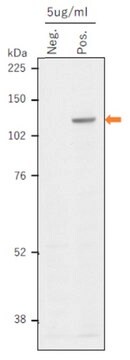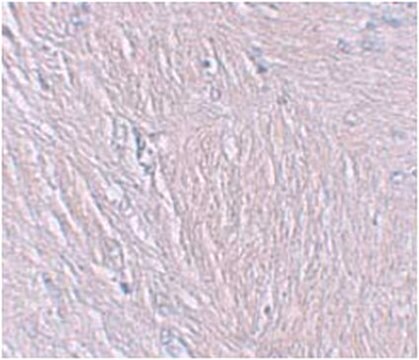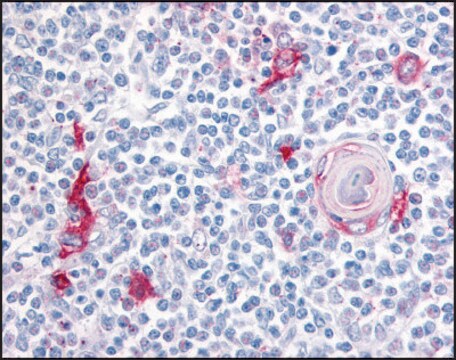MABC1795
Anti-phospho-TERT (Thr249) Antibody, clone TpMab-3
Synonym(e):
EC:2.7.7.49, HEST2, TP2, Telomerase catalytic subunit, Telomerase reverse transcriptase, Telomerase-associated protein 2
About This Item
IHC
WB
immunohistochemistry: suitable
western blot: suitable
Empfohlene Produkte
Biologische Quelle
mouse
Qualitätsniveau
Antikörperform
purified antibody
Antikörper-Produkttyp
primary antibodies
Klon
TpMab-3, monoclonal
Mol-Gew.
calculated mol wt 127 kDa
observed mol wt ~127 kDa
Aufgereinigt durch
using protein G
Speziesreaktivität
human
Verpackung
antibody small pack of 100
Methode(n)
immunofluorescence: suitable
immunohistochemistry: suitable
western blot: suitable
Isotyp
IgG1κ
Epitopsequenz
N-terminal half
Protein-ID-Hinterlegungsnummer
UniProt-Hinterlegungsnummer
Lagertemp.
2-8°C
Angaben zum Gen
human ... TERT(7015)
Spezifität
Immunogen
Anwendung
Isotype testing: Identity confirmation by Isotyping Test.
Isotyping Analysis: The identity of this monoclonal antibody is confirmed by isotyping test to be mouse IgG1k.
Tested Applications
Immunofluorescence Analysis: A representative lot detected TERT in Immunofluorescence applications (Matsuda, Y., et al. (2022). J Pathol. 257(2):172-185).
Western Blotting Analysis: A 1:250 dilution from a representative lot detected TERT in Mitotic HeLa cells with RO3306 treatment (negative) versus mitotic HeLa cell samples (positive), where the positive control samples were obtained by IP using clone 10E9-2 to enrich hTERT ( Data courtesy of Dr. Kenkichi Masutomi, National Cancer Center Research Institute, Tokyo, Japan).
Western Blotting Analysis: A representative lot detected TERT in Western Blotting applications (Matsuda, Y., et al. (2022). J Pathol. 257(2):172-185).
Immunohistochemistry Applications: A representative lot detected TERT in Immunohistochemistry applications (Matsuda, Y., et al. (2022). J Pathol. 257(2):172-185).
Note: Actual optimal working dilutions must be determined by end user as specimens, and experimental conditions may vary with the end user.
Zielbeschreibung
Physikalische Form
Rekonstituierung
Lagerung und Haltbarkeit
Sonstige Hinweise
Haftungsausschluss
Sie haben nicht das passende Produkt gefunden?
Probieren Sie unser Produkt-Auswahlhilfe. aus.
Lagerklassenschlüssel
12 - Non Combustible Liquids
WGK
WGK 1
Flammpunkt (°F)
Not applicable
Flammpunkt (°C)
Not applicable
Analysenzertifikate (COA)
Suchen Sie nach Analysenzertifikate (COA), indem Sie die Lot-/Chargennummer des Produkts eingeben. Lot- und Chargennummern sind auf dem Produktetikett hinter den Wörtern ‘Lot’ oder ‘Batch’ (Lot oder Charge) zu finden.
Besitzen Sie dieses Produkt bereits?
In der Dokumentenbibliothek finden Sie die Dokumentation zu den Produkten, die Sie kürzlich erworben haben.
Unser Team von Wissenschaftlern verfügt über Erfahrung in allen Forschungsbereichen einschließlich Life Science, Materialwissenschaften, chemischer Synthese, Chromatographie, Analytik und vielen mehr..
Setzen Sie sich mit dem technischen Dienst in Verbindung.








